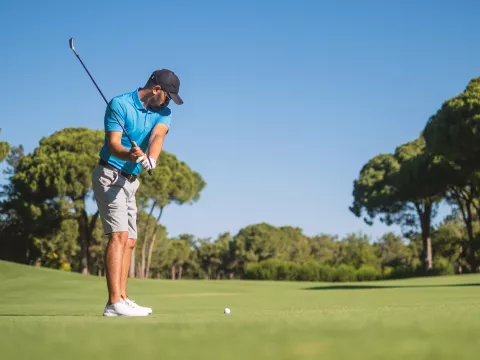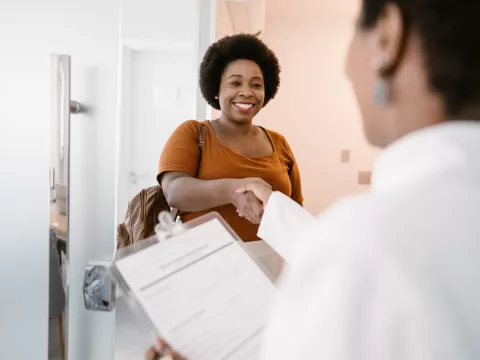- AdventHealth

Choose the health content that’s right for you, and get it delivered right in your inbox.
As you follow through on a golf swing, your grip tightens and your wrist curves, engaging the muscles of your wrist and forearm. As you swing again and again, you strain the same parts of your arm and elbow.
Over time, the inside of your elbow may start to throb with occasional very sharp, stabbing pain. The pain may come from the tendon that attaches the muscles in your wrist to your arm bone at the elbow.
This condition is called golfer’s elbow, or medial epicondylitis, though the injury isn’t limited to golfing alone. Any repetitive action that uses the wrists, like turning a screwdriver or pitching a ball, can cause or aggravate it.
Who’s At Risk for Golfer’s Elbow?
Golfer’s elbow is typically caused by repeated activity that involves turning the wrist and flexing the elbow. In golfers, our physicians see it most commonly in those who tend to hook the ball rather than slice it. It’s also seen in rowers, tennis players who hit their forehand with a lot of topspin and in weightlifters, too.
Treatment and Prevention Strategies
No matter what causes their pain, a person with golfer’s elbow generally wants two things: an end to the pain and the ability to return to their hobby, sport or job.
In most cases, a combination of intermittent icing to reduce swelling, topical anti-inflammatory medication, stretching and rest are enough to reduce pain and allow the tendon to heal so there can be a gradual return to full activity.
In the long term, forearm strengthening exercises can prevent the pain from returning. There are several other causes of inner elbow pain beyond golfer’s elbow that your physician can evaluate if these measures don’t work.
In rare cases of golfer’s elbow, injections and/or surgery are used to remove damaged tissue and allow the tendon to heal.
Surgery is a very rare intervention, and typically, less than 10% of people with golfer’s elbow require surgery.
Do You Have Golfer’s Elbow?
The first thing to consider is where you’re hurting. If the pain comes from the inside part of the elbow, it could be golfer’s elbow. If it comes from the other side of your elbow, near the point, it could be a related condition, sometimes called tennis elbow or lateral epicondylitis.
The pain of golfer’s elbow might radiate from the elbow along the inside of your forearm and may feel worse with grasping, shaking hands or lifting objects.
Other symptoms may include a weak grip, stiffness, numbness or tenderness at the inner elbow (painful to the touch).
What Can Help?
There are several key ways to treat golfer’s elbow pain.
The first is rest. In many cases, avoiding the repetitive activity that caused the pain for a couple of weeks will relieve it.
If rest alone doesn’t work, a gentle ice massage, over-the-counter 1% diclofenac gel or an over-the-counter force brace or sleeve may be used. If the pain persists, a prescription for occupational therapy for muscle strengthening and stretching and massage of the injury has been shown to promote recovery.
If these measures don’t help, there are some minimally invasive treatments that can be performed. Occasionally, a corticosteroid injection may be recommended at the discretion of your physician. If chosen, cortisone injections should be limited to one or two at most.
Micro-needling under ultrasound guidance is a technique in which the damaged tendon is removed to promote tendon healing. An alternative that shows promising results includes platelet-rich plasma injections, which is when the physician uses the healing properties of your own cells to facilitate healing the tendon in your elbow. However, this procedure, while promising, may not be covered by insurance.
When the above methods don’t work, or advanced imaging such as an MRI shows a large tear in the tendon, surgery may be needed. It involves removing the damaged tendon, repairing and occasionally grafting the tendon to restore full function and eliminate pain.
Prescription: Prevention
After the pain goes away — or, ideally, before it even starts — golfers, weightlifters and other active adults can take steps to prevent the pain altogether.
There are several general ways to prevent the pain of golfer’s elbow:
- Ensure your grip is not too tight on the golf club and use proper mechanics
- Build forearm strength through gentle targeted exercises
- Routinely stretch the muscles that flex your wrist
- Use ice for 10 to 20 minutes after activity to reduce swelling
- Take an over-the-counter oral or topical anti-inflammatory medication on active days
Many athletes and hobbyists can give their elbow tendon a break by changing their form. Weightlifters can keep their elbows closer to their bodies and rowers can change their grip.
Here to Help You Get Back in the Game
Don’t let golfer’s elbow sideline you. For the answers you need and the care you deserve, count on our orthopedic experts. We deliver whole-person solutions that help relieve pain and get you back to the active life you love. Learn more about our orthopedic care, including shoulder and elbow treatments.




